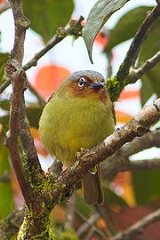
Chestnut-faced Babbler
Encyclopedia
The Chestnut-faced Babbler (Zosterornis whiteheadi) is a species of bird
in the Old World babbler
family Timaliidae.
It is endemic to the island of Luzon
in the Philippines
. There are two subspecies, Z. w. whiteheadi in northern and central Luzon, and Z. w. sorsogonensis in south eastern Luzon. The species is generally found in mountain forests, generally above 1000 m (although occasionally down to 100m. Within its range is catholic in its choice of habitat, frequenting broadleaf forests, moist mossy forests, pine forest, open forest, scrub and human modified habitat as well.
The Chestnut-faced Babbler is a medium sized babbler, 15 cm in length and weighing between 17-28 g. The plumage
of this species is not sexually dimorphic, that of juveniles has not been described. They have a chestnut face with a grey crown and nape, and an incomplete white eye ring. The wings and tail are olive-brown and the flanks paler olive, tending towards buff-yellow on the breast. The subspecies Z. w. sorsogonensis is similar, but the crown and nape are edged in black. The call is described as rapid, busy and metallic.
The species feeds on seeds, fruit, insects (particularly beetle
s) and spiders. Single birds, pairs or flocks of up to thirty will feed, usually in the lower growth of the forest, but occasionally up to the canopy. They will join mixed-species feeding flock
s with other species. Water is obtained from pitcher plants.
Bird
Birds are feathered, winged, bipedal, endothermic , egg-laying, vertebrate animals. Around 10,000 living species and 188 families makes them the most speciose class of tetrapod vertebrates. They inhabit ecosystems across the globe, from the Arctic to the Antarctic. Extant birds range in size from...
in the Old World babbler
Old World babbler
The Old World babblers or timaliids are a large family of mostly Old World passerine birds. They are rather diverse in size and coloration, but are characterised by soft fluffy plumage. These are birds of tropical areas, with the greatest variety in Southeast Asia and the Indian Subcontinent...
family Timaliidae.
It is endemic to the island of Luzon
Luzon
Luzon is the largest island in the Philippines. It is located in the northernmost region of the archipelago, and is also the name for one of the three primary island groups in the country centered on the Island of Luzon...
in the Philippines
Philippines
The Philippines , officially known as the Republic of the Philippines , is a country in Southeast Asia in the western Pacific Ocean. To its north across the Luzon Strait lies Taiwan. West across the South China Sea sits Vietnam...
. There are two subspecies, Z. w. whiteheadi in northern and central Luzon, and Z. w. sorsogonensis in south eastern Luzon. The species is generally found in mountain forests, generally above 1000 m (although occasionally down to 100m. Within its range is catholic in its choice of habitat, frequenting broadleaf forests, moist mossy forests, pine forest, open forest, scrub and human modified habitat as well.
The Chestnut-faced Babbler is a medium sized babbler, 15 cm in length and weighing between 17-28 g. The plumage
Plumage
Plumage refers both to the layer of feathers that cover a bird and the pattern, colour, and arrangement of those feathers. The pattern and colours of plumage vary between species and subspecies and can also vary between different age classes, sexes, and season. Within species there can also be a...
of this species is not sexually dimorphic, that of juveniles has not been described. They have a chestnut face with a grey crown and nape, and an incomplete white eye ring. The wings and tail are olive-brown and the flanks paler olive, tending towards buff-yellow on the breast. The subspecies Z. w. sorsogonensis is similar, but the crown and nape are edged in black. The call is described as rapid, busy and metallic.
The species feeds on seeds, fruit, insects (particularly beetle
Beetle
Coleoptera is an order of insects commonly called beetles. The word "coleoptera" is from the Greek , koleos, "sheath"; and , pteron, "wing", thus "sheathed wing". Coleoptera contains more species than any other order, constituting almost 25% of all known life-forms...
s) and spiders. Single birds, pairs or flocks of up to thirty will feed, usually in the lower growth of the forest, but occasionally up to the canopy. They will join mixed-species feeding flock
Mixed-species feeding flock
A mixed-species feeding flock, also termed a mixed-species foraging flock, mixed hunting party or informally bird wave, is a flock of usually insectivorous birds of different species, that join each other and move together while foraging...
s with other species. Water is obtained from pitcher plants.

